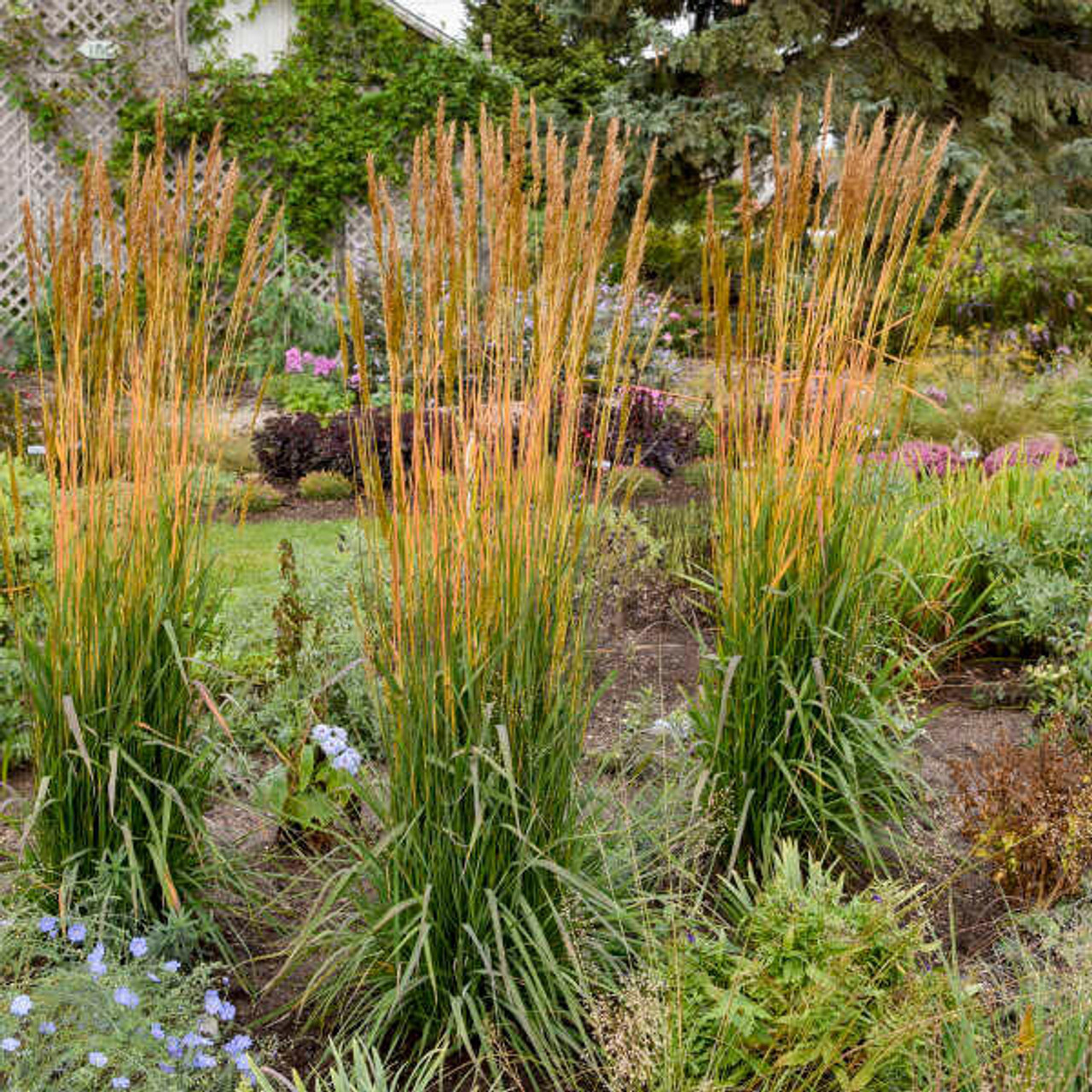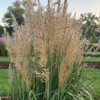Product Description
Sorghastrum nutans GOLDEN SUNSET® ('MNYG318153' PP33776) (30)ct Flat
Common Name: Yellow Prairie Grass
A native selection with vertical landscape application comparable to Calamagrostis 'Karl Foerster'; however GOLDEN SUNSET® stands taller at 5-6' and flowers much later in the season. Wide leaves form a solid base with long golden seedheads rising above the plant in late summer. Wheat-like seedheads reach 10-12" in length and hold their form, adding winter interest.
From the University of Minnesota Landscape Arboretum.
Height: 5.0-6.0 Feet
Spread: 2.0-3.0 Feet
Hardiness Zones: 3,4,5,6,7,8,9
Flower Color: Yellow Shades Gold/Orange Shades
Foliage Color: Green shades
Full Sun
Low to Consistent Water
Poor to Fertile Soil Quality
Bloomtime: Late Summer
Deer and Rabbit Resistant
Seasonal Interest: Dried Seed Heads, Fall Color
Growth Rate: Medium
Border Plant, Cut Flower, Cut Foliage, Dried Flower, Easy To Grow, Good For Screening, Attractive Foliage, Mass Planting, Salt Tolerant, Focal Point, Native to North America
Sorghastrum nutans 'Golden Sunset' is a warm-season ornamental grass that brings a burst of golden color and graceful texture to gardens. It is a popular choice for its upright habit, attractive seedheads, and adaptability to a variety of conditions. Here is a closer look at what makes it special:
Appearance:
- Foliage: 'Golden Sunset' features slender, upright, olive-green foliage that forms a dense clump. The leaves provide a beautiful backdrop for the showy seedheads.
- Seedheads: In late summer, the plant produces a profusion of long, golden-bronze seedheads that rise above the foliage. The seedheads resemble wheat and add a touch of airy elegance to the garden. They persist into winter, providing visual interest and food for birds.
Growing Conditions:
- Light: Thrives in full sun (at least 6 hours of direct sunlight) for optimal growth and flowering. It can tolerate some light shade but may not be as upright or colorful in shadier conditions.
- Soil: Adaptable to a wide range of well-drained soils, from dry to moist. It can even tolerate poor, degraded soil and heavy clay.
- Water: Prefers regular watering, especially during the establishment period. Once established, it has good drought tolerance.
Characteristics:
- Mature Size: Reaches a height of 4-6 feet with a spread of 3 feet, forming an upright, clump-forming habit.
- Hardiness Zones: Suitable for USDA hardiness zones 3-9, making it a versatile choice for various climates.
- Growth Habit: Forms a dense, upright clump that adds vertical interest to the garden.
Why it is Popular:
- Golden Seedheads: The showy, golden-bronze seedheads create a beautiful and eye-catching display in the garden.
- Upright Habit: Its upright habit adds vertical interest and structure to garden beds and borders.
- Adaptability: 'Golden Sunset' is a tough and adaptable plant that can tolerate a wide range of conditions, including drought, heat, and cold.
- Low Maintenance: It is relatively low-maintenance, requiring minimal care once established.
- Wildlife-Friendly: The flowers attract pollinators, and the seedheads provide food and shelter for birds.
Uses:
- Borders: Adds vertical interest and texture to garden borders.
- Naturalized Areas: Its adaptability and native roots make it an excellent choice for naturalized areas and meadows.
- Mass Plantings: Creates a stunning display when planted in groups, providing a sea of golden seedheads.
- Erosion Control: Its strong root system helps prevent erosion on slopes and banks.
- Winter Interest: The persistent seedheads provide visual interest in the winter garden.
Additional Information:
- 'Golden Sunset' is a cultivar of Indian grass (Sorghastrum nutans), a native North American grass.
- It was selected for its upright stature, clean foliage, and numerous early yellow and golden-bronze flowers.
- It is a warm-season grass, meaning it starts growing actively in late spring and reaches its peak in late summer and fall.
- Leaving the seed heads in place over winter provides visual interest and food for birds.
- Dividing clumps every few years helps maintain plant vigor and prevents overcrowding.
Overall, Sorghastrum nutans 'Golden Sunset' is a fantastic choice for gardeners seeking a beautiful, low-maintenance, and adaptable ornamental grass. Its golden seedheads, upright habit, and wildlife-friendly nature make it a valuable addition to any garden, bringing beauty and texture throughout the growing season and beyond.
Thirty (30) plants per flat (or tray). Approximate Plug Measurements: 3 inches deep x 2 inches wide.
Other Details
The most important part of the plant is its root system. Healthy roots are the foundation of a healthy, vibrant plant. The type of plug container used is based on the specific needs of the plants. Perennials offered as bare root traditionally perform better when planted as bare root.Planted in a specialized mix, potted plants have well established root systems. Top growth stage will vary depending on the current life cycle and time of year when shipped. In Winter and early Spring dormant plants may be shipped. Dormant plants may be planted right away, even before the last frost date.
Most bare root varieties are field grown for at least one season, though Hemerocallis and Hosta are grown for two seasons. The bulk of the soil is removed during the harvesting process and the tops of most varieties are trimmed back to the crown. They are graded, packed in shredded aspen or sphagnum moss and stored in freezers until ready to be shipped.
See our Container Sizes and Bare Root Perennials pages for more information.
Plant information and care is provided in the Overview section, Plant Genus Page and general information is provided in the Planting Care & Guides. Additional questions can be asked on each Plant page.
Plant Spacing: Using the maximum mature spread or width of a plant to guide spacing, ensures space to grow to full size. To fill an area sooner, plant them closer together. Just remember, future thinning or transplanting may be needed.
Water: Keep a close eye on newly planted perennials, especially throughout the first growing year. Most early plant loss is due to too much or too little water!







